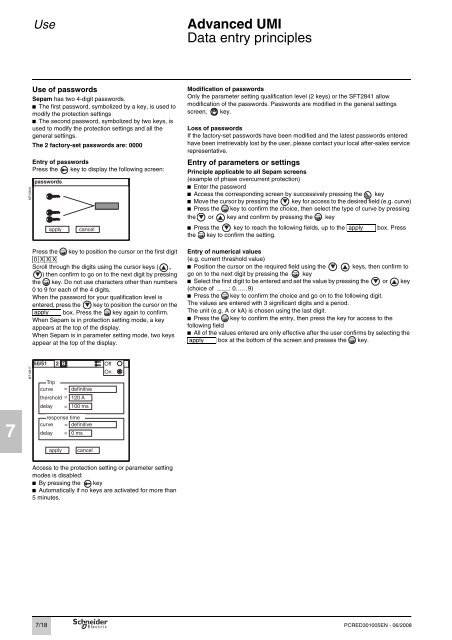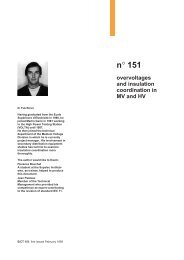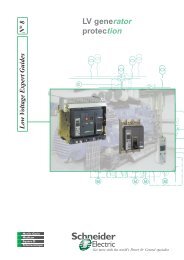sepam 20 user manual - Schneider Electric
sepam 20 user manual - Schneider Electric
sepam 20 user manual - Schneider Electric
You also want an ePaper? Increase the reach of your titles
YUMPU automatically turns print PDFs into web optimized ePapers that Google loves.
7<br />
Use Advanced UMI<br />
Data entry principles<br />
Use of passwords<br />
Sepam has two 4-digit passwords.<br />
b The first password, symbolized by a key, is used to<br />
modify the protection settings<br />
b The second password, symbolized by two keys, is<br />
used to modify the protection settings and all the<br />
general settings.<br />
The 2 factory-set passwords are: 0000<br />
MT10816<br />
Entry of passwords<br />
Press the key to display the following screen:<br />
reset<br />
Press the key to position the cursor on the first digit<br />
0 X X X<br />
Scroll through the digits using the cursor keys ( ,<br />
) then confirm to go on to the next digit by pressing<br />
reset<br />
the key. Do not use characters other than numbers<br />
0 to 9 for each of the 4 digits.<br />
When the password for your qualification level is<br />
entered, press the key to position the cursor on the<br />
reset<br />
apply box. Press the key again to confirm.<br />
When Sepam is in protection setting mode, a key<br />
appears at the top of the display.<br />
When Sepam is in parameter setting mode, two keys<br />
appear at the top of the display.<br />
MT10817<br />
passwords<br />
Access to the protection setting or parameter setting<br />
modes is disabled:<br />
b By pressing the key<br />
b Automatically if no keys are activated for more than<br />
5 minutes.<br />
7/18<br />
apply cancel<br />
Trip<br />
curve = definitive<br />
thershold = 1<strong>20</strong> A<br />
delay = 100 ms<br />
response time<br />
curve =<br />
definitive<br />
delay = 0 ms<br />
apply cancel<br />
Off<br />
On<br />
Modification of passwords<br />
Only the parameter setting qualification level (2 keys) or the SFT2841 allow<br />
modification of the passwords. Passwords are modified in the general settings<br />
screen, key.<br />
Loss of passwords<br />
If the factory-set passwords have been modified and the latest passwords entered<br />
have been irretrievably lost by the <strong>user</strong>, please contact your local after-sales service<br />
representative.<br />
Entry of parameters or settings<br />
Principle applicable to all Sepam screens<br />
(example of phase overcurrent protection)<br />
b Enter the password<br />
b Access the corresponding screen by successively pressing the key<br />
b Move the cursor by pressing the key for access to the desired field (e.g. curve)<br />
reset<br />
b Press the key to confirm the choice, then select the type of curve by pressing<br />
reset<br />
the or key and confirm by pressing the key<br />
b Press the key to reach the following fields, up to the apply box. Press<br />
reset<br />
the key to confirm the setting.<br />
Entry of numerical values<br />
(e.g. current threshold value)<br />
b Position the cursor on the required field using the keys, then confirm to<br />
reset<br />
go on to the next digit by pressing the key<br />
b Select the first digit to be entered and set the value by pressing the or key<br />
(choice of : 0……9)<br />
reset<br />
b Press the key to confirm the choice and go on to the following digit.<br />
The values are entered with 3 significant digits and a period.<br />
The unit (e.g. A or kA) is chosen using the last digit.<br />
reset<br />
b Press the key to confirm the entry, then press the key for access to the<br />
following field<br />
b All of the values entered are only effective after the <strong>user</strong> confirms by selecting the<br />
reset<br />
apply box at the bottom of the screen and presses the key.<br />
PCRED301005EN - 06/<strong>20</strong>08

















